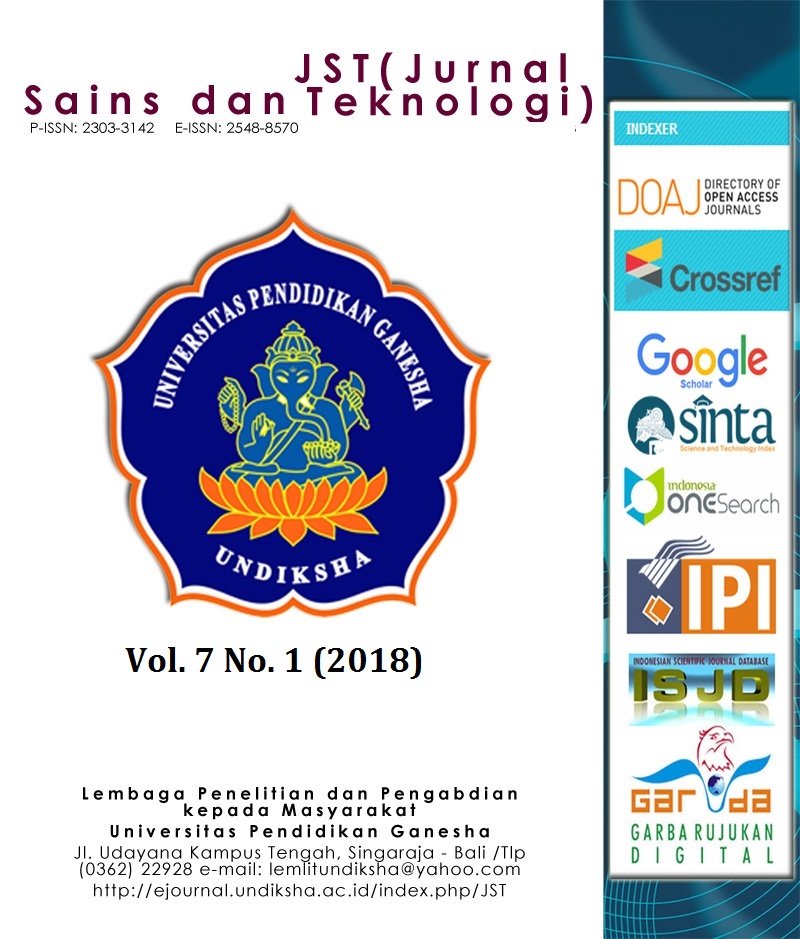PENGEMBANGAN SISTEM PENGAMAN PINTU LABORATORIUM ROBOTIKA UIN SULTAN SYARIF KASIM BERDASARKAN SIULAN BERBASIS SENSOR FC-04 DAN MIKROKONTROLER ATMEGA 328
DOI:
https://doi.org/10.23887/jstundiksha.v7i1.12930Keywords:
Arduino Uno, Selenoid, Relay, Sensor Suara FC -04Abstract
Perkembangan teknologi berdampak positif bagi kehidupan manusia. Sistem rumah pintar yang sedang berkembang pesat dituntut agar dapat melayani konsumen. Sehingga, konsumen dapat merasakan keuntungan dari teknologi tersebut. Mengingat angka pencurian di Indonesia yang semakin meningkat dan perlunya sistem keamanan yang mampu bekerja terus menerus secara otomatis. Maka dari itu, dalam penelitian ini dikembangkan sebuah sistem pengaman kunci pintu otomatis sesuai dengan kondisi laboratorium robotika UIN Sultan Syarif Kasim. Berdasarkan pengujian yang telah dilakukan pada alat tersebut, maka dapat disimpulkan bahwa alat ini telah diuji dan dapat digunakan untuk membantu sistem keamanan pada pintu rumah berdasarkan intensitas suara dari siulan yang diterima oleh sensor suara FC -04 sebesar 91,1 dBA sampai 95,4 dBA.References
Ario, G. R. (2015). Magnetic Door Lock Menggunakan kode Pengaman Berbasis Atmega 328. Universitas Negeri Yogyakarta. Yogyakarta.
Badan Pusat Statistik. (2016). Jumlah Tindak Pidana Menurut Kepolisian Daerah, 2000 - 2016. Retrieved February 10, 2018, from https://www.bps.go.id/statictable/2009/02/21/1570/jumlah-tindak-pidana-menurut-kepolisian-daerah-2000---2016.html
Lawu, B. L., Adiono, T., Putra, R. V. W., Fathany, M. Y., Afifah, K., Santriaji, M. H., & Fuada, S. (2016). Prototyping design of electronic end-devices for smart home applications. Proceedings - 2016 IEEE Region 10 Symposium, TENSYMP 2016, 4(c), 261–265. https://doi.org/10.1109/TENCONSpring.2016.7519415
Raka Agung, I. S. (2012). Rancang Bangun Prototipe Penghitung Jumlah Orang Dalam Ruangan Terpadu Berbasis Mikrokontroler Atmega328P, 11, 132–206.
S. Anderson. (2014). The making off controlling system to sliding door for house. Poli Rekayasa, Vol.10 no., 73–85.
Saputro, Eko dan Wibawanto, H. (2016). Rancang Bangun Pengaman Pintu Otomatis Menggunakan E-KTP Berbasis Mikrokontroler Atmega328. Jurusan Teknik Elektro, Fakultas Teknik, Universitas Negeri Semarang, Vol 8, No.
Shabani, H., Julai, N., Ahmed, M. M., Helmi, A., & Rose, C. (n.d.). Intelligent Greenhouse Monitoring and Control System Based Arduino UNO Microcontroller, 9(3), 65–69.
Stankovic, J. A., Lee, I., Mok, A., & Rajkumar, R. (2005). Opportunities and obligations for physical computing systems. Computer, 38(11), 23–31. https://doi.org/10.1109/MC.2005.386
Downloads
Published
How to Cite
Issue
Section
License
Authors who publish with the Jurnal Sains dan Teknologi (JST) agree to the following terms:
- Authors retain copyright and grant the journal the right of first publication with the work simultaneously licensed under a Creative Commons Attribution License (CC BY-SA 4.0) that allows others to share the work with an acknowledgment of the work's authorship and initial publication in this journal.
- Authors are able to enter into separate, additional contractual arrangements for the non-exclusive distribution of the journal's published version of the work (e.g., post it to an institutional repository or publish it in a book), with an acknowledgment of its initial publication in this journal.
- Authors are permitted and encouraged to post their work online (e.g., in institutional repositories or on their website) prior to and during the submission process, as it can lead to productive exchanges, as well as earlier and greater citation of published work. (See The Effect of Open Access)
















